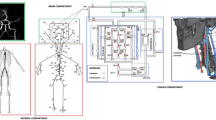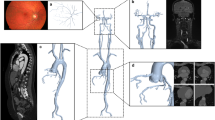Abstract
Human hemodynamic responses during exposure to multi-axial acceleration was a relatively new topic in the fields of acceleration physiology. This study aimed to focus on these responses, especially variations of blood perfusion to brain and eyes, through mathematical modeling. A mathematical model was established using lumped parameter methods, containing compartments of four heart chambers, systemic arteries and veins, circulation of typical systemic organs, and some compartments for pulmonary circulation, together with autonomic regulation considered. This model was firstly validated by using experimental data from experiment of posture change and centrifuge tests of +Gz accelerations, and then applied to analyze human hemodynamic responses to typical multi-axial accelerations. Validation results demonstrated the mathematical model could generate reasonable responses of human cardiovascular system during posture change and exposure to +Gz accelerations. Simulation results of hemodynamic responses to multi-axial accelerations depicted Gy induced significant differences of blood flow to the left and right eyes. And some contour maps were generated based on these results, which provided a quick way to estimate blood flow variations in brain and eyes during exposure to different accelerations.

This study aimed to focus on variations of blood perfusion to brain and eyes during exposure to typical multi-axial accelerations through mathematical modeling. This model was firstly validated by using experimental data from experiment of posture change and centrifuge tests of +Gz accelerations, and then applied to analyze human hemodynamic responses to typical multi-axial accelerations. Simulation results of hemodynamic responses to multi-axial accelerations depicted Gy induced significant differences of blood flow to the left and right eyes. And contour maps that generated based on these results provided a quick way to estimate blood flow variations in brain and eyes during exposure to different accelerations.









Similar content being viewed by others
References
Pollock RD, Firth RV, Storey JA et al (2019) Hemodynamic resposes and G protection afforded by three different anti-G systems. Aerosp Med Hum Perform 90:925–933
Eiken O, Kolegard R, Bergsten E et al (2007) G protection: interaction of straining maneuvers and positive pressure breathing. Aviat Space Environ Med 78:392–398
Burton RR (1988) G-induced loss of consciousness: definition, history, current status. Aviat Space Environ Med 59:2–5
Burton RR, Leverett SD, Michaelson ED (1974) Man at high sustained +Gz acceleration: a review. Aerosp Med 45:1115–1136
Whinnery JE, Burton RR (1987) +Gz-induced loss of consciousness for training exposure to unconsciousness. Aviat Space Environ Med 58:468–472
Whinnery JE, Burton RR, Boll PA, Eddy DR (1987) Characterization of the resulting incapacitation following unexpected +Gz-induced loss of consciousness. Aviat Space Environ Med 58:631–636
Whinnery JE, Shaffstall RM (1979) Incapacitation time for G-induced loss of consciousness. Aviat Space Environ Med 50:83–85
Whinnery JE, Shaffstall RM, Leverett SD (1978) Loss of consciousness during air combat maneuvering. Aerosp Saf 34:23–25
Wood EH, Lamber EH (1989) Objective documentation and monitoring of human Gz tolerance when unprotected and when protected by anti-G suits or M-1 type straining maneuvers alone or in combination. Saf J 19:39–48
Henry JP, Gauer OH, Kety SS et al (1951) Factors maintaining cerebral circulation during gravitational stress. J Clin Invest 30:292–300
Albery WB (2004) Acceleration in other axes affects+ gz tolerance: dynamic centrifuge simulation of agile flight. Aviat Space Environ Med 75:1–6
Xu Y, Yong W, Wei YW et al (2015) Effects of combining ± Gx or ± Gy with ± Gz acceleration on anti-G tolerance. Space Med Med Eng 28:336–340. (in Chinese)
Popplow JR, Veghte JH, Hudson KE (1983) Cardiopulmonary responses to combined lateral and vertical acceleration. Aviat Space Environ Med 54:632–636
Rauscher FG, Brandl H, Baumbach P (2008) The effects of larger g-forces on the aberration pattern of the human eye. J Mod Opt 55:819–838
Snyder MF, Rideout VC (1969) Computer simulation studies of the venous circulation. IEEE Trans Biomedl Eng 16:325–334
Jaron D, Moore TW, Bai J (1988) Cardiovascular responses to acceleration stress: a computer simulation. Proc IEEE 76:700–707
Whinnery JE, Hickman JR (1988) Acceleration tolerance of asymptomatic aircrew with mitral valve prolapse and significant +Gz-induced ventricular dysrhythmias. Aviat Space Environ Med 59:711–717
Cirovic S, Walsh C, Fraser WD (2000) A mathematical model of cerebral perfusion subjected to Gz acceleration. Aviat Space Environ Med 71:514–521
Thomas H, Shim EB, Kamm RD et al (2002) Computational modeling of cardiovascular response to orthostatic stress. J Appl Physiol 92:1239–1254
Olufsen MS, Ottesen JT, Tran HT et al (2005) Blood pressure and blood flow variation during postural change from sitting to standing: model development and validation. J Appl Physiol 99:1523–1537
Gisolf J, Lieshout JJV, Heusden KV et al (2004) Human cerebral venous outflow pathway depends on posture and central venous pressure. J Physiol 560:317–327
Liang F, Liu H (2006) Simulation of hemodynamic responses to the valsalva maneuver: an integrative computational model of the cardiovascular system and the autonomic nervous system. J Physiol Sci 56 (1):45–65
Spronck B, Martens E, Gommer ED et al (2012) A lumped parameter model of cerebral blood flow control combining cerebral autoregulation and neurovascular coupling. AJP Heart Circul Physiol 303 (9):H1143–53
Moore TW, Jaron D, Hrebien L et al (1993) A mathematical model of G time-tolerance. Aviat Space Environ Med 64:947–951
Zamanian SA (2007) Modeling and simulating human cardiovascular response to acceleration. Dissertation, Massachusetts Institute of Technology
Lu HB, Zhang J, Bai J et al (2007) Mathematical modeling of high g protection afforded by various anti-g equipment and techniques. Aviat Space Environ Med 78:100–109
Wang YW, Sun HD, Wei JN et al (2018) A mathematical model of human heart including the effects of heart contractility varying with heart rate changes. J Biomech 75:129–137
Tipton DA, Marko AR, Ratino DA (1984) The effects of acceleration forces on night vision. Aviat Space Environ Med 55:186–190
Keijsers JMT, Leguy CAD, Huberts W et al (2016) Global sensitivity analysis of a model for venous valve dynamics. J Biomech 49:2845–2853
Ottesen JT, Danielsen M (2003) Modeling ventricular contraction with heart rate changes. J Theor Biol 222:337–346
Danielsen M (1998) Modeling of feedback mechanisms which control the heart function in a view to an implementation in cardiovascular models. Dissertation, Roskilde University
Wang JH, Wang YW, Zhang J et al (2019) In vivo measurements of collapse behavior of human internal jugular vein during head-up tilt tests. Physiol Meas 40:075006
Ethier CR, Simmons CA (2007) Ocular biomechanics. In: Introductory biomechanics, from cells to organisms. Cambridge University Press, Cambridge, pp 271–274
Shubrooks SJ, Leverett SD (1973) Effect of the valsalva maneuver on tolerance to +Gz acceleration. J Appl Physiol 34:460–466
Heller LJ, Mohrman DE (2010) Cardiovascular physiology. McGraw-Hill Medical, New York
Garcia JPS, Garcia PMT, Rosen R (2002) Retinal blood flow in the normal human eye using the canon laser blood flowmeter. Ophthalmic Res 34:295–299
Labropoulos N, Watson WC, Mansour MA et al (1998) Acute effects of intermittent pneumatic compression on popliteal artery blood flow. Arch Surg 133:1072–1075
Radegran G (1997) Ultrasound doppler estimates of femoral artery blood flow during dynamic knee extensor exercise in humans. J Appl Physiol 83:1383–1388
Valdueza JM, von Münster T, Hoffman O et al (2000) Postural dependency of the cerebral venous outflow. Lancet 355:200–201
Cirovic S, Walsh C, Fraser WD et al (2003) The effect of posture and positive pressure breathing on the hemodynamics of the internal jugular vein. Aviat Space Environ Med 74:125– 131
Doepp F, Schreiber SJ, Münster TV et al (2004) How does the blood leave the brain? a systematic ultrasound analysis of cerebral venous drainage patterns. Neuroradiology 46:565–570
Niggemann P, Kuchta J, Grosskurth D et al (2011) Position dependent changes of the cerebral venous drainage-implications for the imaging of the cervical spine. Cent Eur Neurosurg 72:32–37
Frydrychowski AF, Winklewski PJ, Guminski W (2012) Influence of acute jugular vein compression on the cerebral blood flow velocity pial artery pulsation and width of subarachnoid space in humans. PLoS ONE 7:e48245
Bateman GA (2002) Pulse-wave encephalopathy: a comparative study of the hydrodynamics of leukoaraiosis and normal-pressure hydrocephalus. Neuroradiology 44:740–748
Ge X, Yin Z, Fan Y, Vassilevski Y, Liang F (2018) A multi-scale model of the coronary circulation applied to investigate transmural myocardial flow. Int J Numer Method Biomed Eng 34(10):e3123
Kozlovsky P, Zaretsky U, Jaffa AJ et al (2014) General tube law for collapsible thin and thick-wall tubes. J Biomech 47(10):2378–2384
Matsuzaki Y, Ikeda T, Kitagawa T et al (1994) Analysis of flow in a two-dimensional collapsible channel using universal tube law. J Biomech Eng 116(4):469–476
Bertram CD (1987) The effects of wall thickness, axial strain and end proximity on the pressure-area relation of collapsible tubes. J Biomech 20(9):863–876
Bertram CD (1982) Two modes of instability in a thick-walled collapsible tube conveying a flow. J Biomech 15(3):223–224
Funding
This work was supported by the Aeronautical Science Foundation of China (2017ZC51024), the Defense Industrial Technology Development Program (JCKY2016601B009), the National Natural Science Foundation of China (12072018, 11602013), the 111 Project 345 (B13003).
Author information
Authors and Affiliations
Corresponding authors
Ethics declarations
Conflict of interest
The authors declare that they have no conflict of interest.
Additional information
Publisher’s note
Springer Nature remains neutral with regard to jurisdictional claims in published maps and institutional affiliations.
Weipeng Li and Bitian Wang contributed equally to this work.
Electronic supplementary material
Below is the link to the electronic supplementary material.
Rights and permissions
About this article
Cite this article
Li, W., Wang, B., Wang, Y. et al. Variations of human cerebral and ocular blood flow during exposure to multi-axial accelerations. Med Biol Eng Comput 60, 471–486 (2022). https://doi.org/10.1007/s11517-021-02472-1
Received:
Accepted:
Published:
Issue Date:
DOI: https://doi.org/10.1007/s11517-021-02472-1




